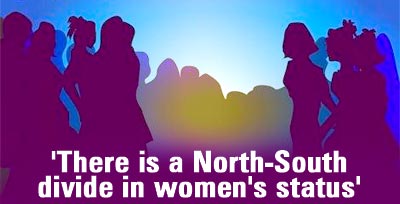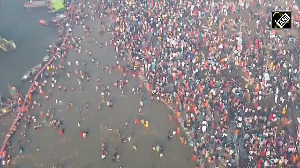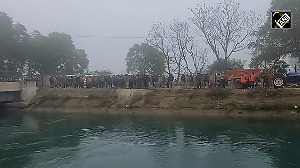
When Registrar General and Census Commissioner Jayanth Kumar Banthia released the India Census 2001 report at a press conference in New Delhi last week, he stirred the proverbial hornet's nest. Sure enough, the Bharatiya Janata Party kicked up a row, proclaiming that the faster growth rate of the country's Muslim population would create social imbalances. Despite repeated clarification by the census office, misgivings about the Muslim growth rate persist.
In an exclusive interview with Chief Correspondent Onkar Singh in New Delhi, R G Mitra, deputy registrar general, defended the findings of the census and expressed deep anguish at the manner in which sections of the media and political parties are tarnishing the image of his organisation. "We are both hurt and pained," he said. Excerpts:
What are your findings regarding the Muslim growth rate?
It is unfortunate that despite repeated clarifications, some sections of the media and political parties are continuing to play up the finding that the Muslim population growth rate has increased sharply in the last 10 years in comparison to other communities, whose growth rate has dropped.
What is the reality?
The reality is that the Muslim growth rate is not as is being projected. We have clarified in our footnotes that in 1981 there was no census in Assam. In 1991, the census could not be held in Jammu and Kashmir. The Muslim population in both states is substantial. So when we added the Muslim population of the two states, it suddenly looks as if the Muslim growth rate is much more. Which is not true. If we had included these figures in the 1981 and 1991 census, then the figures would have looked different.
Are you upset about it?
Naturally we are upset about it. We are both hurt and pained that some sections of the media and the political parties are deliberately trying to tarnish our image. Jayant Kumar Banthia and his officers are deeply pained at the manner in which the very credibility of the office of census commissioner is being questioned.
We have the best and most competent officers. We are all professional people and we have put in a lot of hard work to arrive at the findings. In the whole controversy people have overlooked the fact that we have completed a mammoth task successfully. It hurts when you see someone trying to destroy the credibility of an organisation with one stroke of the pen.
Were you trying to point out that a particular community has greater fertility?
It is unfortunate that nobody seems to have read the report in full. The report very clearly brings out that there are other factors which also influence the growth of population. Illiteracy and women's empowerment are directly related to the population explosion. There is a North-South divide in the status of women. One community may have lower fertility rates than the other, but the main thing is that when it comes to having a child an educated woman does have a say in such matters. Muslim literacy in South India is more than the literacy of Hindus and the growth rate amongst the two communities is almost the same.
Would you say the Muslims are increasingly understanding the importance of having fewer children?
I would not like to say anything on this matter. But generally speaking Indian citizens do realise the importance of having a small family. When a woman is educated, then the whole family is educated, and this ultimately reflects on the growth rate. An educated woman has a better view of the world and understands the implications of a bigger family. The northeastern states have a different culture. They have a tribal culture and hence they view things from their own point of view.
I would appeal to the people and the media not to take a narrow view of our findings. I am not willing to take issue with the political parties on these matters.
How many people were deployed and what kind of money was spent on the exercise?
We employed over two million enumerators to visit about 20 crore households all over the country. The responses of the householders were scanned and tabulated by our officers and men who saved Rs 650 crore than if the work had been done manually. The tabulation work was done with state-of-the-art technology and huge scanners and finally evaluated using big computers. The work began on February 9 and ended on February 28, 2004, for the first phase. The second phase began on March 1 and ended on March 5.
In all we scanned over 200 million papers before doing the tabulation work. We have spent Rs 1,000 crore on the exercise. We had a massive challenge before us and we are happy that we completed it successfully. Despite what people say about us, we are happy with what we have achieved.
What would you say was the biggest achievement of this exercise?
I would say that our biggest achievement was completing the census in the trouble-torn state of Jammu and Kashmir. We had a large number of enumerators doing the job. The people of the state came out and answered questions. Not a single person hired by the census commissioner was either attacked or injured in the process. Jammu and Kashmir has a population of 1,01,43,700, of which 67,93,140 are Muslims and the rest belong to other communities.
But let me emphasize that the Kashmir census is just one of our many achievements which are not being highlighted by the media.
Such as?
We have in our report given hard statistics about the fall in ratio between males and females in many states of the Indian Union. Female foeticide is prevalent in Rajasthan, Haryana, Punjab, and many other states. Hence there is a disparity in the sex ratio. The first provisional report came in 2001 and we had pointed out even then this growing disparity between males and females. We had mentioned that the child sex ratio was so bad in the country that the government should do something about it. As a result of our warning some positive steps were taken, but it did not help in increasing the child sex
ratio.
Counting of one billion people is an achievement in itself.
Did you leave out illegal migrants during the count?
It is not our job to find out who is a legal migrant and who is an illegal migrant. We enlisted all. When we go to a household we do not ask whether he is a legal migrant or illegal migrant. For us, those who answer our questions are Indian citizens.
Headline Image: Uday Kuckian






 © 2025
© 2025